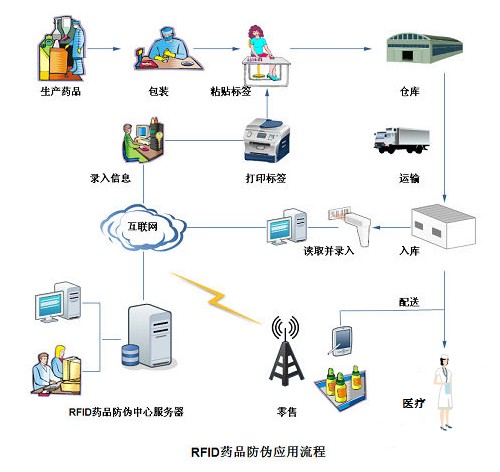First, the program overview
RFID non-contact radio frequency identification technology to establish a drug supply chain anti-counterfeiting traceability system, can achieve real-time tracking and supervision of drugs in the production, circulation, distribution and retail and other links. RFID anti-counterfeiting traceability breaks through the traditional anti-counterfeiting thinking and takes new measures. Specific supply chain key data can be traced: from the time the drug leaves the factory, the RFID tag is attached to the drug packaging, it has become an inseparable part of the drug, the RFID tag carries all the information, and the principle of RFID used for anti-counterfeiting in the commodity anti-counterfeiting is that the commodity identification number ( ID) is the anti-counterfeiting code (which is encrypted by hardware or software algorithms) is traced and managed through the system management platform, from the subsequent supply chain process of the drug to the patient through the retailer or hospital.
Second, the background of the program
At present, the pharmaceutical industry is currently facing the problem of the proliferation of counterfeit and inferior drugs, and medicine is related to the health and life safety of thousands of patients, and there must be no mistakes. However, some criminals, driven by interests, manufacture counterfeit drugs, which threaten the safety of human life after consumers take them. Combined with the current social problems such as the difficulty of seeing a doctor in society and the imperfect medical system, the manufacture and sale of counterfeit drugs is undoubtedly worse. Although the anti-counterfeiting of drugs uses various technologies, it is still a proposition for the serious problems that have emerged now. The system that uses RFID technology to identify anti-counterfeiting traceability functions will assist pharmaceutical companies to fully monitor the whole process of production to shelves to avoid the occurrence of counterfeit and inferior drugs.
Third, the system process

Fourth, the system function
1 The whole process of centralized management
The entire anti-counterfeiting traceability management system is an intelligent management system based on RFID technology, on a complete platform, to achieve the production, warehousing, logistics, final sales, RFID electronic tags of the whole process of carrying these information, convenient data collection and convergence to the management system server center, In terms of the number of management systems, the integrated business management of the whole process such as drug tracking, summary statistical query, information analysis, and printing reports can be carried out.
2. Effectively improve the level of supervision of relevant departments
Due to the lack of basic information, many of the current regulatory work in the field of drug circulation can only stay at the level of post-supervision. When consumers suspect the authenticity of drugs, you can go to the relevant regulatory departments to verify and verify, the regulatory departments only need to set up an RFID reader to read the information to verify the authenticity of drugs and some columns of information, the use of RFID technology, you can achieve the organic unity of advance prevention, supervision during the event, and after-the-fact processing, and achieve full coverage of regulatory work.
3. Real-time tracking, monitoring
Each RFID reader can be connected to the server through GPRS or network, and can effectively record tracking and monitoring in production, warehousing, logistics, and final sales. Timely grasp of the entire process, clear the dynamics of the entire link, medical manufacturers can be based on statistical data in a timely and prepared choice adjustment, can be targeted management. Achieve a real-time information delivery and management.
4. Efficient anti-counterfeiting
RFID tag is the ID card of the drug, the commodity identification number (ID), that is, the anti-counterfeiting code (encrypted by software or hardware algorithms) is written in the RFID chip, this ID It is unique in production and warehousing. In order to prevent criminals from forging and tampering, a secret identifier associated with the ID can be written in the RFID electronic tag to identify the uniqueness of the verification process. The RFID electronic tag identification ID is read-only and unchangeable, and the corresponding read permission assigned to the reader is assigned.
5. Automated data collection
In warehousing and logistics, including the final sale, although the number of times to collect information is many, but the use of RFID readers can be contactless long-distance automatic identification, so as to efficiently collect data. Reduce the complexity of manual statistics and queries; Traditional data acquisition generally stays in manual recording and simple computer management. The RFID reader sends out a certain frequency of RADIO frequency signals through the antenna, when the tag enters the magnetic field, it generates an induced current to obtain energy, sends out information such as its own code, is read and decoded by the reader and sent to the computer host for relevant processing.
6. Standardize the market, improve trust
The current pharmaceutical market is very chaotic, if the promotion of RFID electronic tag technology in pharmaceutical enterprises, pharmaceutical companies will improve the information management capabilities of enterprises, which is very helpful for improving the industry service water products, not giving criminals the opportunity to take advantage of, increasing the competitiveness of enterprises to enhance the credibility and image of enterprises, I believe in RFID Technology will be widely used in the industry in the future.








InfoAsia Việt Nam trở thành nhà cung cấp dịch vụ phần mềm số hóa nhà máy sản xuất cho thương hiệu giày hàng đầu thế giới NEW BALANCE
Công ty TNHH Mây Tre Hà Linh
SAP ERP MES and IOT Project for FVIV Factor
Buwon Industry Co, Ltd
KANGLONGDA VIETNAM PROTECTION TECHNOLOGY COMPANY LIMITED
Shini Group
TA TING PLASTIC (HAI DUONG ) CO., LTD
CÔNG TY TNHH MTV BIÊN HOA SCM